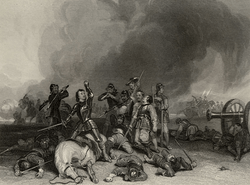Battle of Hopton Heath facts for kids
Quick facts for kids Battle of Hopton Heath |
|||||||
|---|---|---|---|---|---|---|---|
| Part of the First English Civil War | |||||||
 The Battle of Hopton Heath By J. T. Willmore after George Cattermole |
|||||||
|
|||||||
| Belligerents | |||||||
| Commanders and leaders | |||||||
| Earl of Northampton † Henry Hastings Sir Thomas Byron |
Sir John Gell Sir Willam Brereton |
||||||
| Strength | |||||||
| 1,200 | 1,400 | ||||||
The Battle of Hopton Heath was an important fight during the First English Civil War. This war was a big conflict in England between those who supported the King (called Royalists) and those who supported Parliament (called Parliamentarians). The battle happened on Sunday, March 19, 1643.
The Parliamentarian forces were led by Sir John Gell, 1st Baronet and Sir William Brereton. The Royalist side was commanded by Spencer Compton, 2nd Earl of Northampton.
Contents
Why the Battle Happened
Capturing Key Towns
In early March 1643, Sir John Gell and his Parliamentarian forces had a big success. They managed to capture the town of Lichfield in Staffordshire. This was an important win for them.
After Lichfield, Gell wanted to attack another strong Royalist base. This was the town of Stafford. Stafford was very important because it protected the Royalists' supply route. This route connected their ports in Yorkshire to their main city, Oxford.
Planning the Attack
To take Stafford, Gell knew he needed more soldiers. So, he planned to meet up with Sir William Brereton. Brereton was a cavalry commander from Cheshire. Cavalry are soldiers who fight on horseback.
They decided to combine their forces at a place called Hopton Heath. Their meeting was set for March 19.
Royalist Movements
Meanwhile, King Charles had sent his own army into the area. This force was led by the Earl of Northampton. Their job was to take control of the West Midlands and Staffordshire.
Northampton joined up with another Royalist leader, Henry Hastings, at Tamworth. On March 18, the day before the battle, they arrived at Stafford.
The Battle at Hopton Heath
Armies Arrive
On the morning of March 19, Sir John Gell's Parliamentarian troops reached Hopton Heath. The Royalist forces soon found out they were there. By mid-morning, the Royalists started getting ready to move towards the heath.
Around 2:00 PM, Sir William Brereton and his cavalry arrived. The Parliamentarians then took up a strong position. They stood along a ridge on the northeast side of the field.
In total, the Parliamentarian army had about 1,400 men. This included 700 infantry (foot soldiers), 300 dragoons (soldiers who rode horses but fought on foot), and 400 cavalry.
First Attacks
At 3:00 PM, the Royalists arrived. They set up their battle lines to the south of the Parliamentarians. Their combined force had about 1,200 men. This included 300 dragoons and 800 cavalry.
Henry Hastings led the first attack for the Royalists. His dragoons pushed the Parliamentarians back a little at the edges of their line.
Then, both sides started firing their cannons. The Royalists had a very powerful cannon. It was a large 29-pounder known as "Roaring Meg." This cannon caused the most damage.
Northampton's Charges
The Earl of Northampton then led two charges with his cavalry. He aimed for the middle of the Parliamentarian line. But each time, his attack was pushed back.
During his second charge, something dramatic happened. Northampton was thrown from his horse. He landed right in the middle of the Parliamentarian soldiers. He refused to surrender and was killed there.
Fighting Continues
The Royalists quickly regrouped after losing their commander. Sir Thomas Byron then led a third charge against the Parliamentarians. But this attack also failed.
Hastings tried to get the Royalists ready for a fourth charge. However, they were tired and couldn't keep fighting with the same energy. At that moment, Brereton led a Parliamentarian infantry attack. They pushed the Royalists back. They even managed to get back some of the field and cannons they had lost earlier.
Battle Ends
As it started to get dark, the fighting stopped. The Parliamentarians then left the battlefield. The battle was over and did not start again.
Brereton went back to his base in Cheshire. Gell left for Derby, giving up his plan to capture Stafford. The battle was very tough on the Parliamentarians. They had about 500 soldiers killed or wounded. The Royalists had far fewer, with only about 50 killed or wounded. This was because the Royalists mostly used cavalry charges against the Parliamentarians, who were mainly foot soldiers.
What Happened Next
Who Won?
After the battle, both sides said they had won. The Parliamentarians felt they won because they held the field at the end of the day. They also killed the Royalist commander, the Earl of Northampton.
The Royalists, however, believed they won. They reoccupied the field the next morning. They also captured eight of the Parliamentarians' cannons.
Control of Staffordshire
After the battle, Stafford was safe from the Parliamentarian threat. Henry Hastings and the Royalists immediately tried to take back Lichfield. They attacked its strongly defended area, called the Close, on March 21. But they failed.
Two weeks later, Prince Rupert, a famous Royalist commander, arrived in Lichfield. He surrounded the Close. On April 21, the Parliamentarian soldiers inside surrendered. Lichfield then stayed a Royalist stronghold for the rest of the Civil War.
Images for kids


